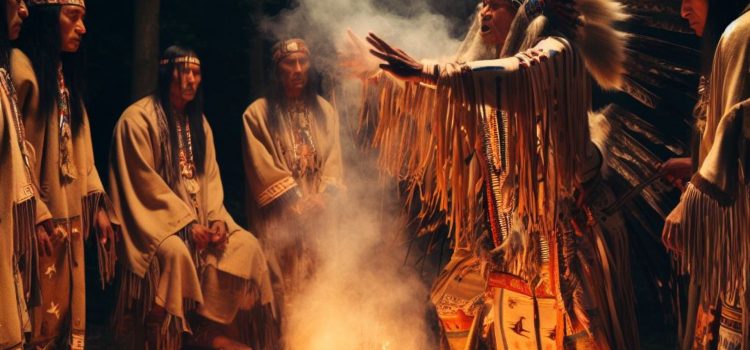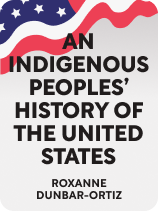

This article is an excerpt from the Shortform book guide to "An Indigenous Peoples' History of the United States" by Roxanne Dunbar-Ortiz. Shortform has the world's best summaries and analyses of books you should be reading.
Like this article? Sign up for a free trial here.
How did the genocide of indigenous people in America happen? What were the colonizers’ tactics?
The genocide of indigenous people in America was accomplished through tactics of total war, a method of decimating a population to force submission. Europeans attacked women, children, and the elderly, and they took or destroyed resources.
Here’s how and why European settlers committed genocide in the Americas.
The Colonial Period
According to popular historical myths, the US colonial period began when a group of settlers believed God ordained them to take over American lands. Some contest this myth, arguing that while religion was certainly one motivating factor, colonizers relied on genocidal war tactics—not just God’s providence—to wrestle American lands away from their indigenous stewards. In this article, we’ll discuss the role those war tactics played in the founding of the first American colonies and the genocide of indigenous people.
Genocidal Warfare in the American Colonies
Many settlers of the first American colonies were Scots-Irish—descendants of Scottish Calvinists who colonized northern Ireland, using violent war tactics like scalping (which we’ll discuss in greater detail later) to force the Irish into submission. (Shortform note: The Scottish Calvinists’ colonization of Ireland in the early 1600s ignited centuries of conflict between indigenous Irish Catholics and English, Scottish, and later Irish Protestants, culminating in The Troubles from 1968 to 1998. As we’ll discuss, their descendants’ settlement of the Americas similarly set off centuries of conflict between indigenous Americans and Anglo settlers.)
These settlers would apply similar tactics, called “total war,” in the Americas. The purpose of total war was to completely decimate the enemy population and quell its ability to resist colonization—in other words, genocide. Small bands of settlers formed militias to attack Native American communities (especially their women, children, and elderly), destroying their villages, fields, food supplies, and roadways. Settlers also introduced other factors that weakened Native Americans, including novel diseases and alcohol, to gain a foothold. Genocidal methods of war like these are intrinsic to settler-colonialism (the kind of colonialism that took place in North America).
All of the early American colonies were established by way of total war. For example, when the Jamestown colony was founded in Virginia, the settlers were unable to provide food for themselves. One of their leaders, John Smith, tried to force the local Powhatan people to provide for them by threatening war against them. Eventually, the colonists aimed to totally exterminate the Powhatan by eradicating all of their agricultural supplies. Having reduced the indigenous population (and therefore the threat of violent resistance), the colonists were then able to safely expand their landbase and accumulate more wealth by bringing in enslaved Africans to work the land.
(Shortform note: Other historians provide additional context about this period of violence between the Powhatan and the English settlers of Jamestown, which is known as the Powhatan War. Powhatan-English relations weren’t violent at first—initially, the Powhatan and English peaceably traded food for technology, and both the Powhatan chief and his daughter Pocahontas worked toward an alliance with the English. However, John Smith rejected their efforts, and soon colonists turned tobacco farming into a lucrative business and sought to control more indigenous lands for that purpose. This led to a campaign of violence against the Powhatan and motivated the importation of enslaved Africans.)
Later, as the colonies expanded, settlers introduced the practice of “scalp hunting,” wherein they could receive money for scalps they collected from Native Americans they killed. This practice motivated settlers to consider all Native Americans potential targets of violence, even when they weren’t actively engaged in war against them. The settlers also introduced ranging—the practice of patrolling and proactively attacking Native American communities without provocation. Together, these activities escalated the genocide of Native Americans.
(Shortform note: Some historians note that some Native Americans also collected scalps from their enemies in battle. However, this was usually for ritual purposes or to attain honor—not for money, as was the case for the colonists. Experts tend to agree that for-profit scalp hunting accelerated anti-indigenous violence in the American colonies because the rewards were significant: In some cases, one could receive up to $12,000 in today’s money or even land in exchange for a scalp. Experts also agree that settlers used ranging to suppress Native Americans—two famous examples of such forces are Rogers’ Rangers and, a century later, the Texas Rangers).
| Understanding Total War, Genocide, and Settler-Colonialism In An Indigenous Peoples’ History of the United States, author Dunbar-Ortiz weaves a complex argument: She says that the first European settlers of the American colonies waged total war against Native Americans. She explains that the goal of total war is the annihilation of the enemy population, which amounts to genocide. She also argues that genocide is intrinsic to settler-colonialism, which is the kind of colonialism she says took place in North America. To help you understand this argument, we’ll define some of these terms and add context from other experts on colonialism, war, and genocide. Experts define total war as a kind of war in which combatants will use any means necessary to achieve victory, regardless of whether their methods are widely considered fair. Governments began developing laws of war—agreements on the kinds of conduct, weapons, combatants, and targets allowed in war—in the 1800s. For example, current international law states that militaries cannot target civilians (citizens of an enemy territory who aren’t engaged in combat). In a total war, enemy forces might disregard those laws. Experts disagree about how to define genocide, but the most commonly accepted definition was established by the United Nations (UN) after the Holocaust. According to the UN, “genocide” refers to any action taken with the aim of annihilating a group of people on the basis of their religion, race/ethnicity, or nationality. For example, the Holocaust qualifies as a genocide because the Nazi regime aimed to wipe out the Jewish population. Historians define settler-colonialism as a process where settlers remove indigenous populations from their homelands so they can take ownership of and occupy those lands. Land occupation is the ultimate goal of settler-colonialism, which sets it apart from other kinds of colonialism (like extractive colonialism, whose ultimate goal is the removal of resources from indigenous lands and which may or may not involve land occupation). While Dunbar-Ortiz argues that genocide is intrinsic to settler-colonialism, anthropologist Patrick Wolfe disagrees: He says that under settler-colonial systems, settlers’ primary goal is land acquisition, not the destruction of a population. This means genocide is not always part of settler-colonialism. Genocide often manifests anyway because destroying indigenous populations can make it easier for settlers to acquire their lands. However, settlers sometimes prefer not to annihilate indigenous populations because they can use them for forced labor; Wolfe argues this was the case in Apartheid-era South Africa. Additionally, while Dunbar-Ortiz says genocide is the purpose of total war, this idea is controversial. In Genocide and the Modern Age, sociologist Eric Markusen explains that some experts define genocide and total war as distinct phenemona, even though they’re alike in that they’re both usually a government-sanctioned process that leads to large-scale destruction of life. Markusen doesn’t say whether he believes they should be classified as distinct phenomena, but he argues that genocide and total war often overlap, citing both World War II and the Vietnam War as potential examples. |

———End of Preview———
Like what you just read? Read the rest of the world's best book summary and analysis of Roxanne Dunbar-Ortiz's "An Indigenous Peoples' History of the United States" at Shortform.
Here's what you'll find in our full An Indigenous Peoples' History of the United States summary:
- A retelling of US history from a Native American perspective
- What led Europe to colonize the Americas
- How patterns of genocide and resistance have played out over the course of US history






